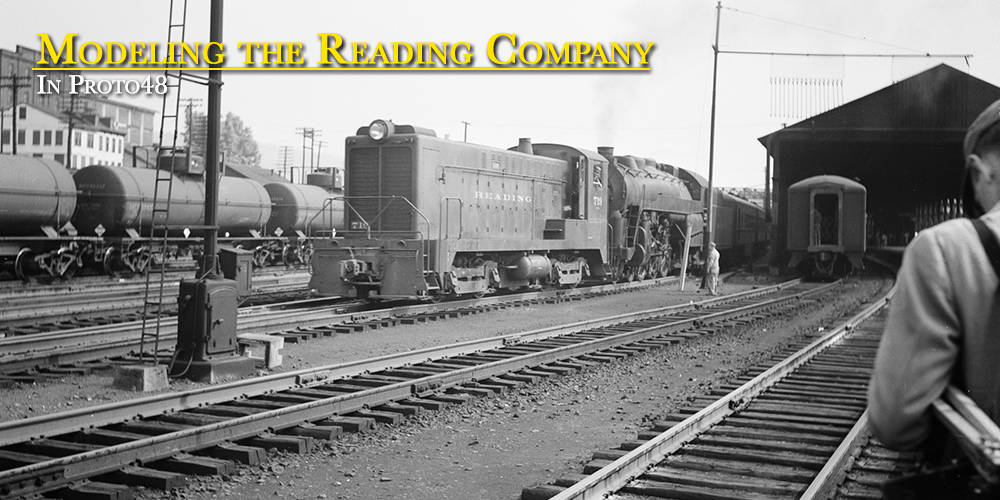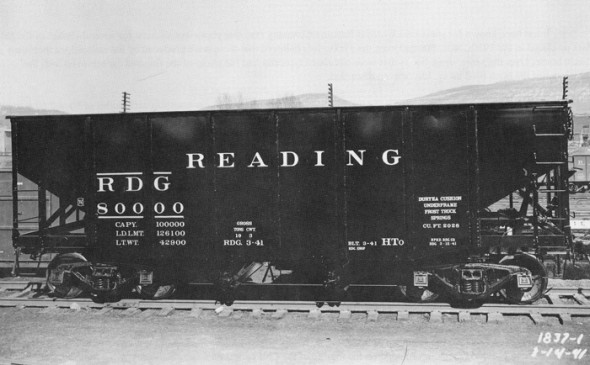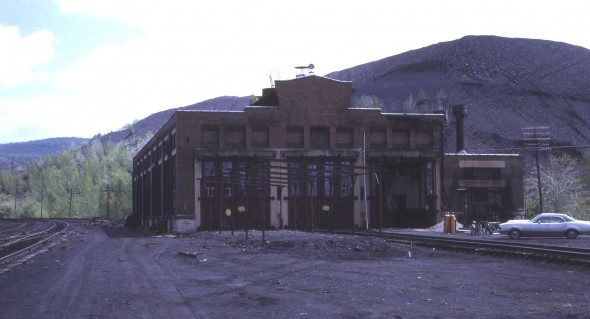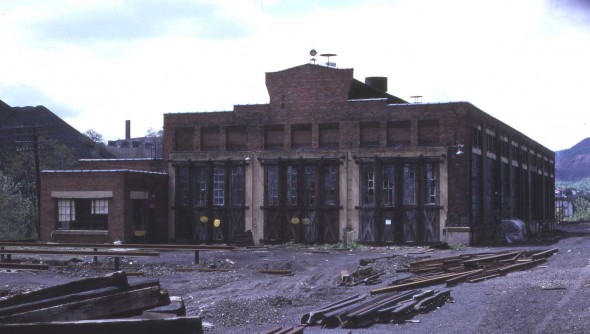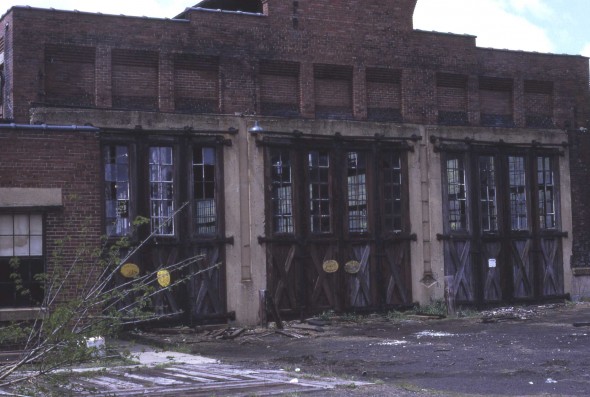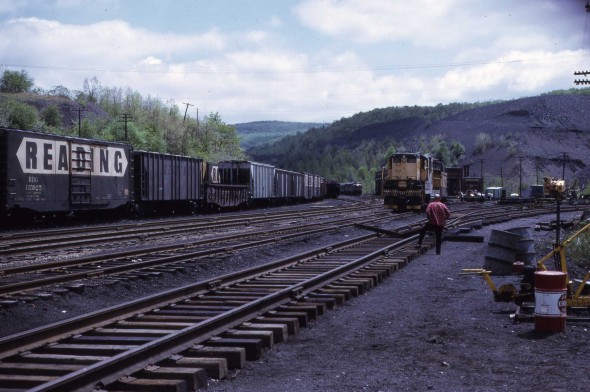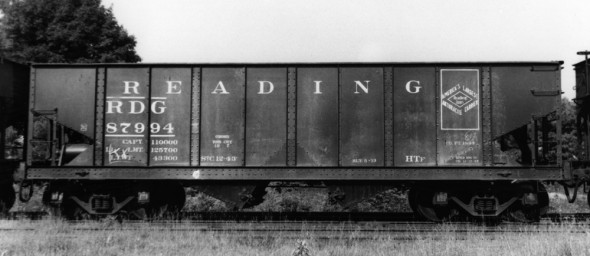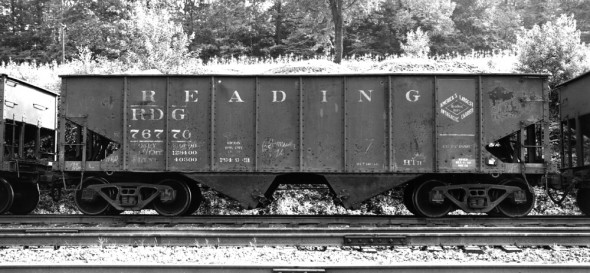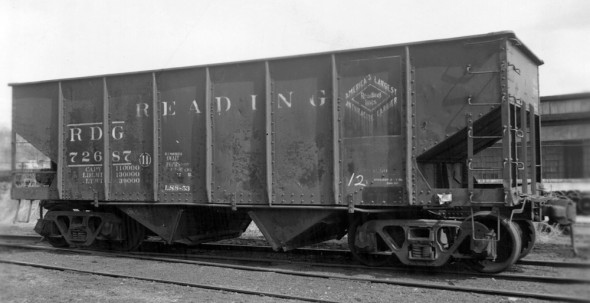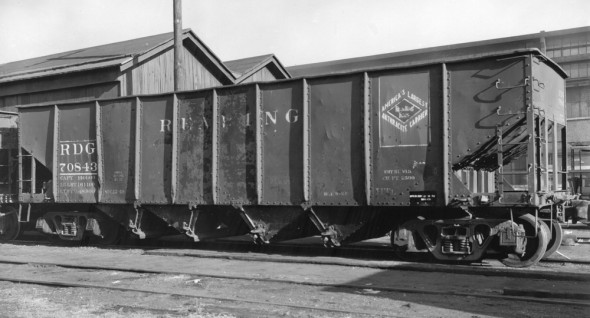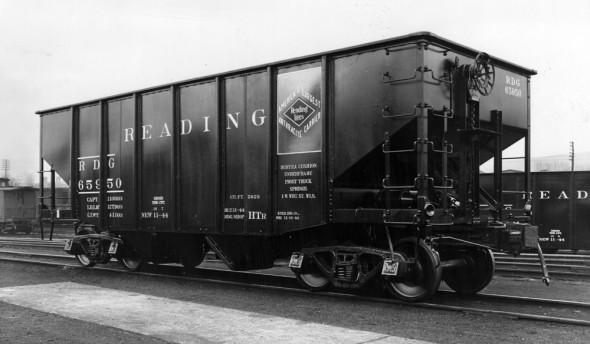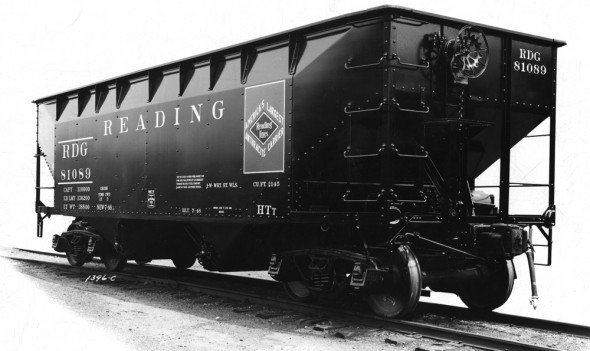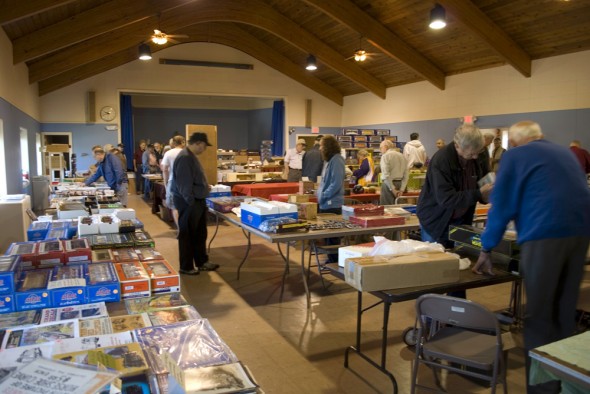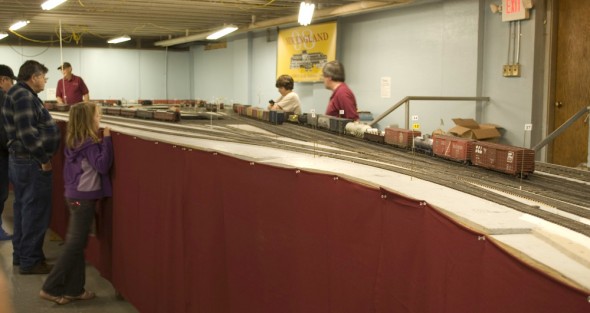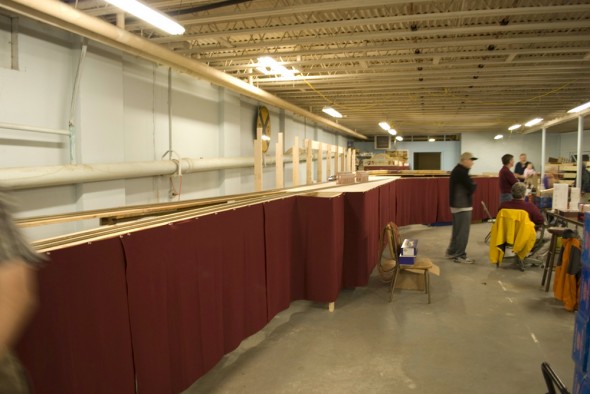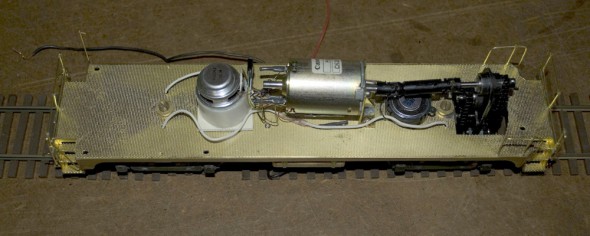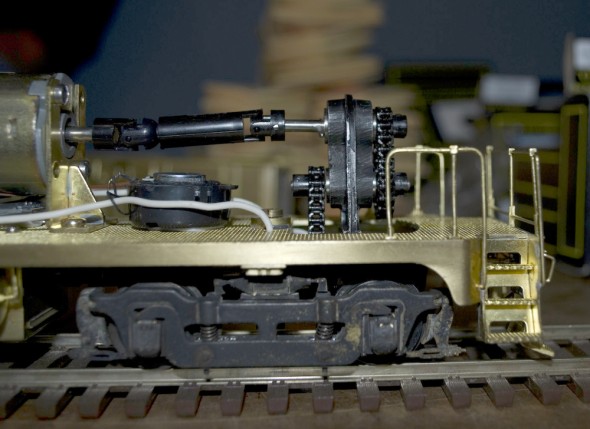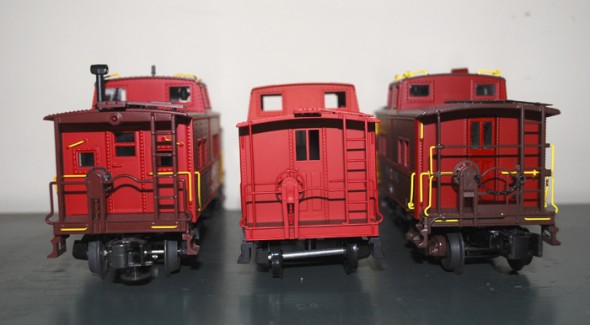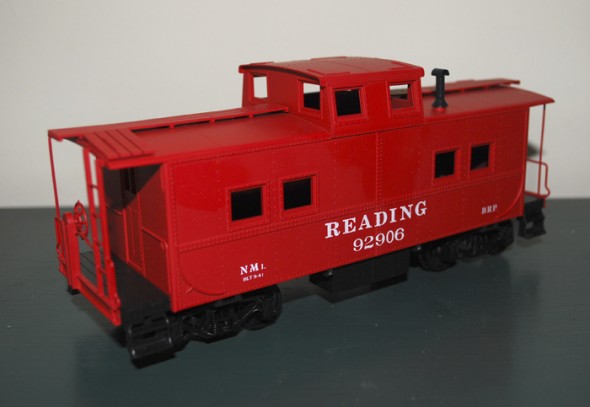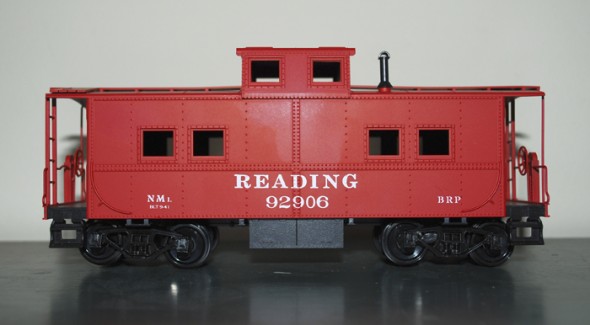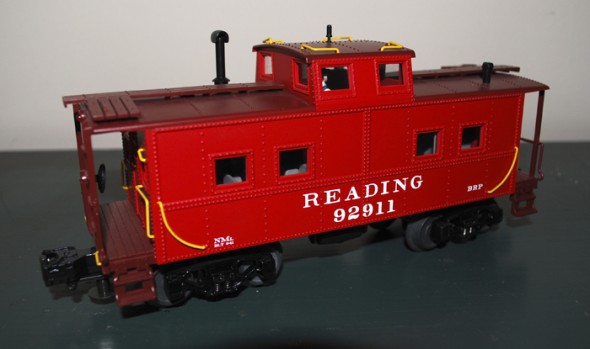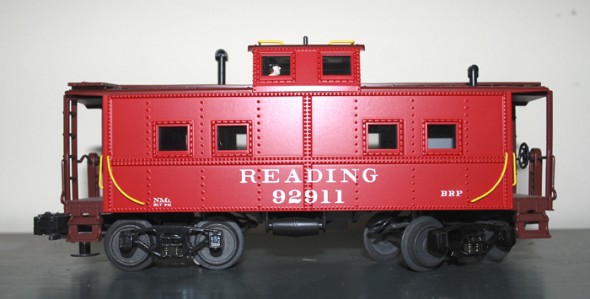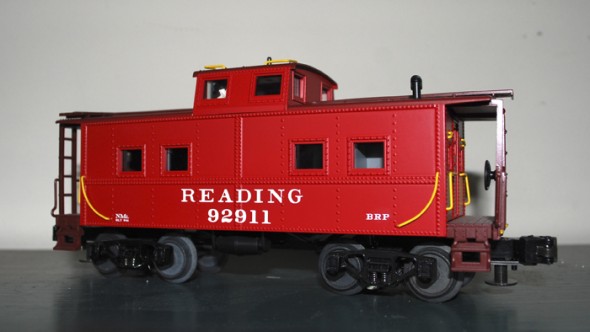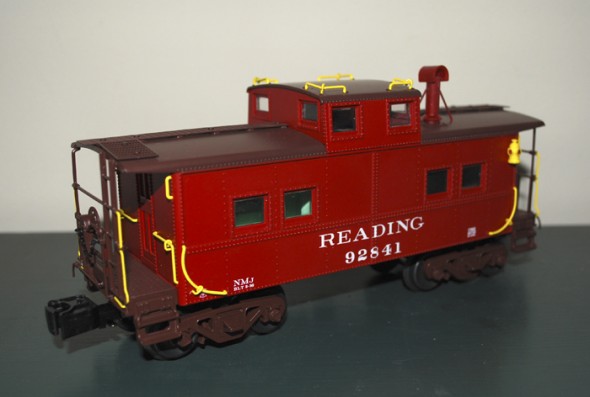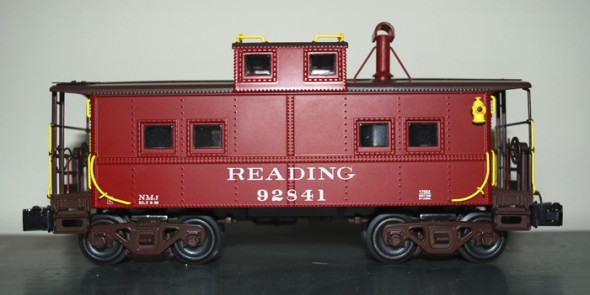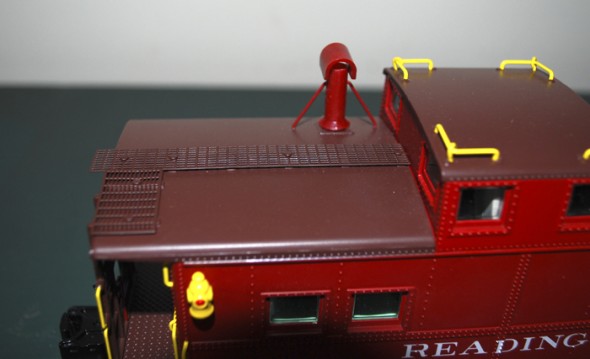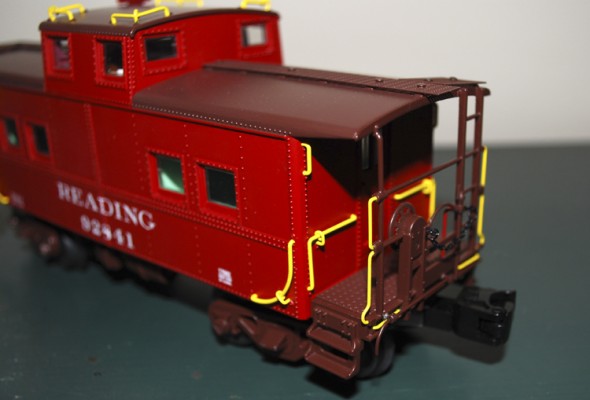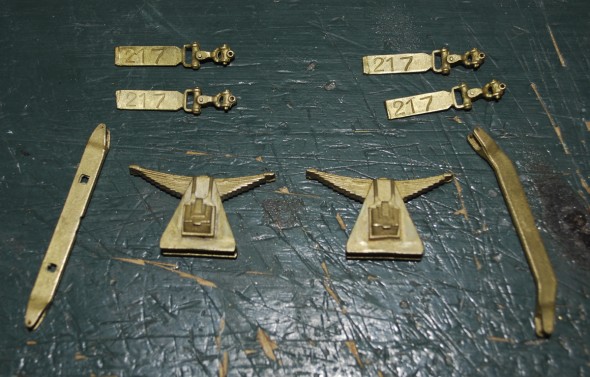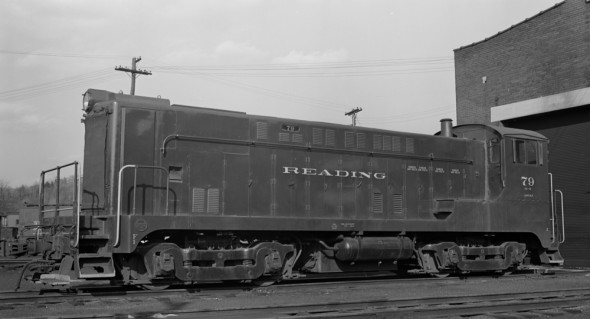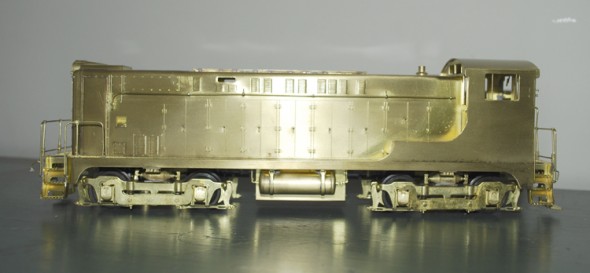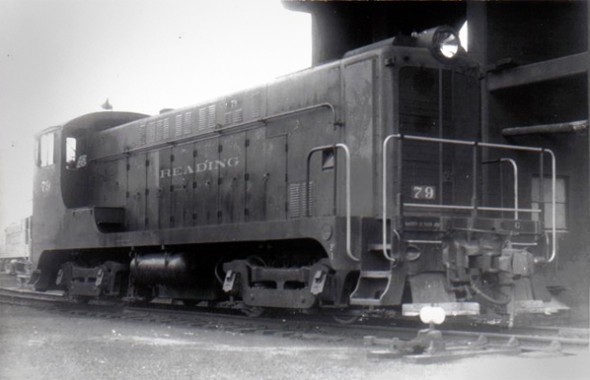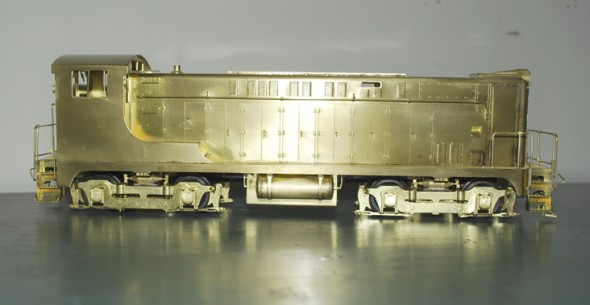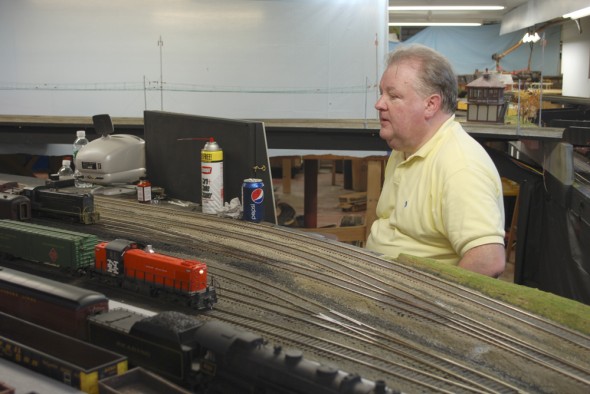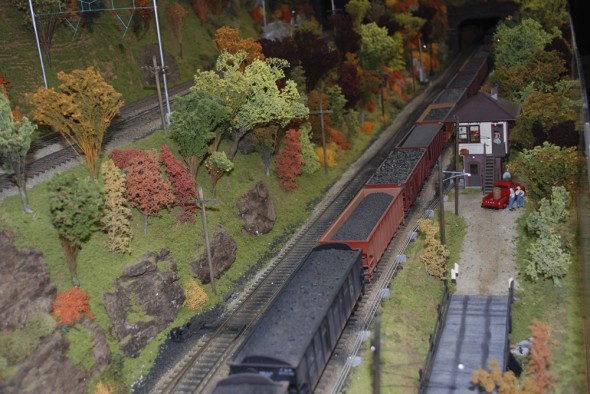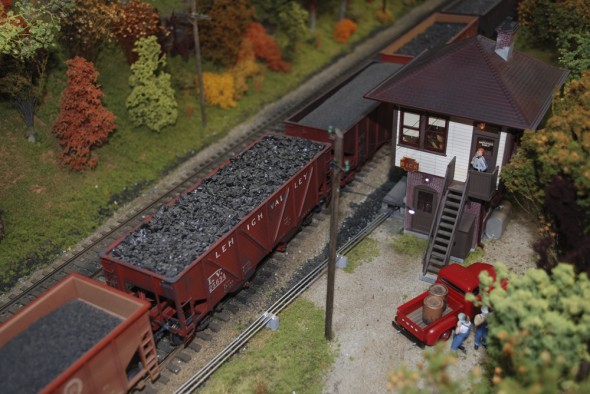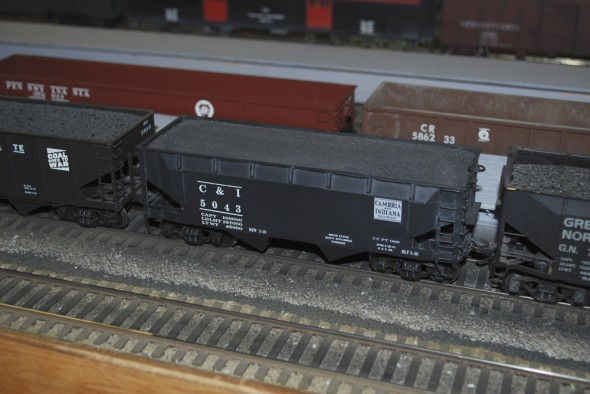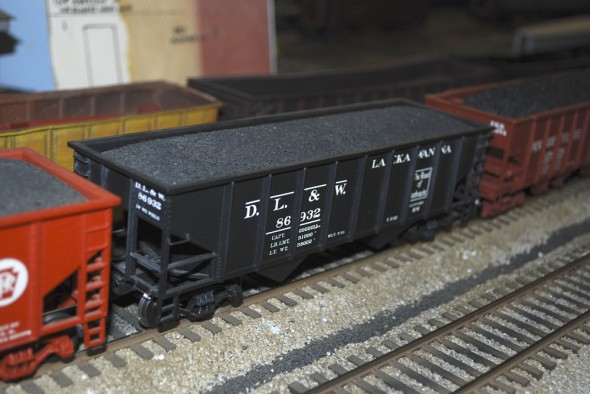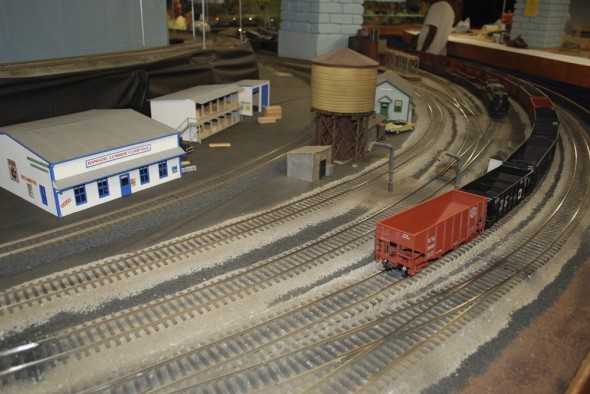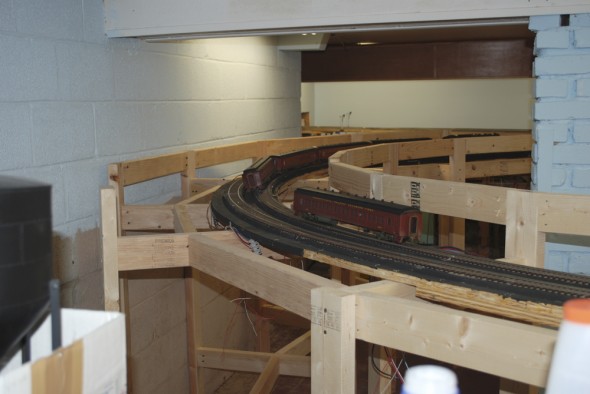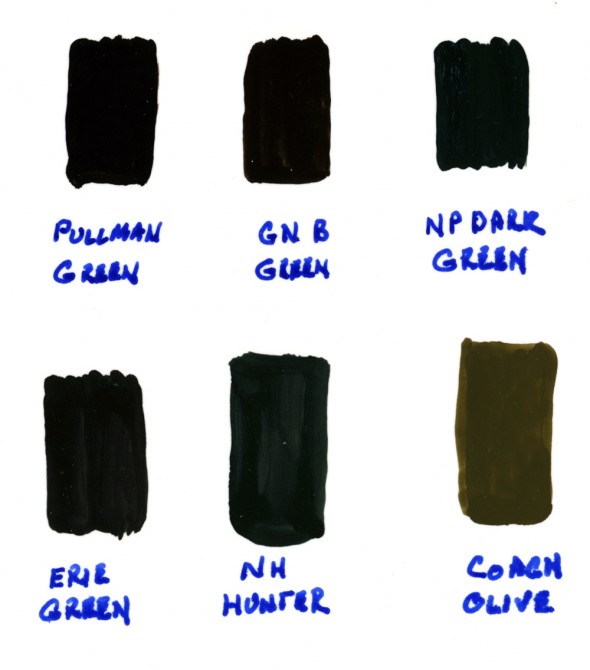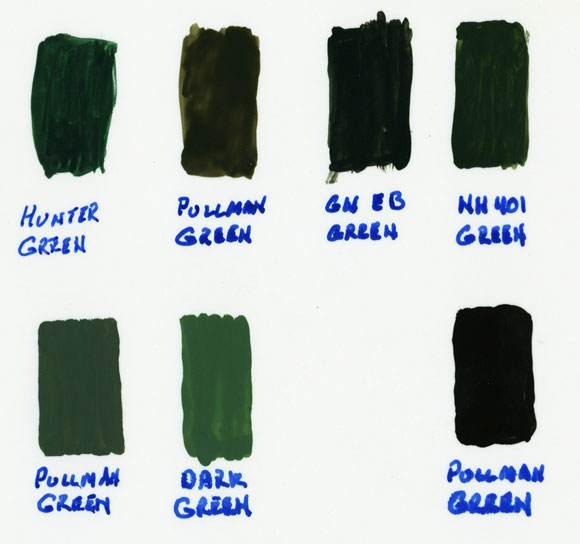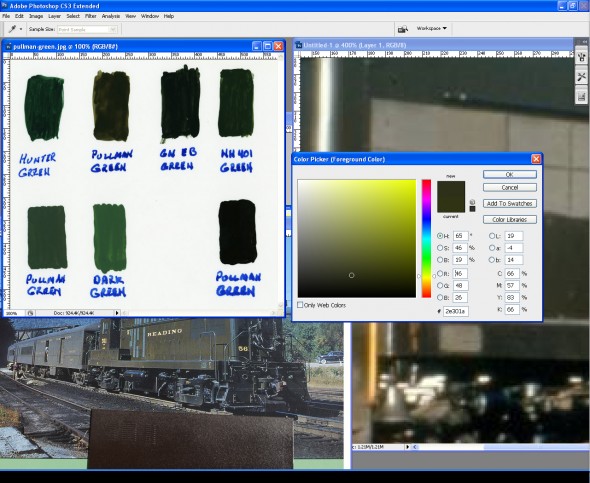Recently some questions about the Reading paint schemes applied to open hopper cars. Here is a company photo of an HTo with the as-built paint scheme.
Author Archives: George Losse
Shamokin Engine House, May 1972
As I explore Shamokin as a possible modeling location, one of the key structures to build will be the engine house at the East end of the Yard.
Back in May of 72 my brother Bobb was chasing an excursion in Shomokin. He sent me some scans of the engine house that he shot that day.
Modeling the Reading Open Hopper Car Fleet in 1952
The Summer of 1952, my modeling period, was a time of change for the Reading open hopper car fleet. The oldest cars of the fleet, class HTf, dated back to 1910 were being retired and the newest HTv’s were being built in 1952.
There were six open hopper car types split into twelve car classes. The majority of the fleet was comprised of 50 ton twin hoppers except for the two classes of 70 ton quad hoppers class HTl and HTn.
In March of 2012, I gave a presentation on “Modeling Reading Company Open Hopper Cars 1948-1956” I’ve posted the handout from the clinic. Dowload the handout
Milestones In Open hopper car painting:
-
1923-1940 Underlined “Reading” Car Number Centered On Car
- 1940 Roman lettering without red herald New with Class HTO
- 1942-1954 Roman lettering with red herald
2-17-42 revision on an HTj paint diagram “Added Stencil “America’s Largest Anthracite Carrier” - 1955-1958 “Speed” lettering with red herald
Reading HTf
| Car Numbers | Builder | Built | Qty Built | 1/52 ORER | Service Life | Inside Length |
| 86000-86999 | American Car & Foundry | 1913 | 1000 | 334 | 1910-1953 | 32′ 10″ |
| 87000-87999 | Cambria Steel Co. | 1913 | 1000 | |||
| 88000-88999 | Standard Steel Car Co. | 1911 | 1000 | |||
| 89000-89999 | American Car & Foundry | 1910 | 1000 |
Reading HTh
| Car Numbers | Builder | Built | Qty Built | 1/52 ORER | Service Life | Inside Length |
| 74500-75499 | Cambria Steel Co. | 1917 | 1000 | 4214 | 1916-1960 | 32′ 10″ |
| 75500-75999 | Standard Steel Car Co. | 1917 | 500 | |||
| 76000-76499 | Pressed Steel Car Co. | 1917 | 500 | |||
| 76500-76999 | Pressed Steel Car Co. | 1916 | 500 | |||
| 77000-77499 | Standard Steel Car Co. | 1917 | 500 | |||
| 77500-77999 | Standard Steel Car Co. | 1916 | 500 | |||
| 78000-78999 | Pressed Steel Car Co. | 1916 | 1000 |
Reading HTj
| Car Numbers | Builder | Built | Qty Built | 1/52 ORER | Service Life | Inside Length |
| 72500-73499 | Standard Steel Car Co. | 1919 | 500 | 1831 | 1919-1964 | 30′ 6″ |
| 73500-74499 | Ralston Steel Car | 1919 | 500 |
Reading HTl
| Car Numbers | Builder | Built | Qty Built | 1/52 ORER | Service Life | Inside Length |
| 70500-70999 | Pressed Steel Car Co. | 1922 | 500 | 3504* | 1922-1964 | 39′ |
| 71000-71499 | Standard Steel Car Co. | 1922 | 500 | |||
| 71500-71999 | Midvale Steel & Ordinance | 1922 | 500 | |||
| 72000-72499 | American Car & Foundry | 1922 | 500 |
Reading HTn
| Car Numbers | Builder | Built | Qty Built | 1/52 ORER | Service Life | Inside Length |
| 68500-69499 | Bethlehem Steel Corp. | 1925 | 1000 | 3504* | 1924-1964 | 39′ |
| 69500-69899 | Pressed Steel Car Co. | 1924 | 400 | |||
| 69900-70099 | Standard Steel Car Co. | 1924 | 200 | |||
| 70100-70299 | Bethlehem Steel Corp. | 1924 | 200 | |||
| 70300-70499 | American Car & Foundry | 1924 | 200 |
*ORER record is for combined totals of both classes HTl and HTn.
Reading HTo
| Car Numbers | Builder | Built | Qty Built | 1/52 ORER | Service Life | Inside Length |
| 80000-80999 | Reading Shops | 1941 | 1000 | 995 | 1941-1976 | 31′-0″ |
Reading HTp
| Car Numbers | Builder | Built | Qty Built | 1/52 ORER | Service Life | Inside Length |
| 67000-67299 | Reading Shops | 1942 | 300 | 339 | 1941-1976 | 31′-0″ |
| 67300-67338 | Reading Shops | 1943 | 39 |
Reading HTr
| Car Numbers | Builder | Built | Qty Built | 1/52 ORER | Service Life | Inside Length |
| 65000-65999 | Reading Shops | 1944 | 1000 | 996 | 1944-1976 | 31′-0″ |
Reading HTs
| Car Numbers | Builder | Built | Qty Built | 1/52 ORER | Service Life | Inside Length |
| 66000-66999 | Reading Shops | 1943 | 1000 | 995 | 1943-1976 | 31′-0″ |
| 67339-67999 | Reading Shops | 1944 | 661 | 659 | 1944-1976 |
Reading HTss
| Car Numbers | Builder | Built | Qty Built | 1/52 ORER | Service Life | Inside Length |
| 66000-67999 | Reading Shops | 1951 | 2 | 1951-1976 | 31′-0″ |
Reading HTt
| Car Numbers | Builder | Built | Qty Built | 1/52 ORER | Service Life | Inside Length |
| 81000-81999 | Bethlehem Steel Corp. | 1948 | 1000 | 1000 | 1948-1967 | 33′-0″ |
Reading HTu
| Car Numbers | Builder | Built | Qty Built | 1/52 ORER | Service Life | Inside Length |
| 82000-82749 | Bethlehem Steel Corp. | 1949 | 750 | 749 | 1949-1967 | 33′-0″ |
Reading HTv
| Car Numbers | Builder | Built | Qty Built | 1/52 ORER | Service Life | Inside Length |
| 83000-83999 | Bethlehem Steel Corp. | 1950 | 1000 | 3000 | 1950-1967 | 33′-0″ |
| 84000-84999 | Bethlehem Steel Corp. | 1951 | 1000 | |||
| 85000-85999 | Bethlehem Steel Corp. | 1952 | 1000 |
Note more HTv’s were built AFTER my modeling period of 1952.
Layout Visit: Southern New England Model Railroad Club, 2010 Show
Well I decided to take a little ride today, to visit the Southern New England Model Railroad Club layout and attend their O scale Show located in Gardner Massachusetts. From my home in South Jersey Google Maps said it was a 5.5 hour drive so I wanted to get an early start. The wife and I got into the car around 4:30 am. We arrived at the show a little before 10:00 am.
The show was not as big as some of the other O scale shows I’ve attended, but it also wasn’t as small as some of the shows in the past. There was a different selection of dealers at the show which was a refreshing change of pace.
After walking around the show, I headed down to the basement of the auditorium to see the club layout. I didn’t see a track plan posted anywhere so I could not tell exactly how far along they are. But what they had built was working nicely.
One of the highlights for me at the show was getting to see Bob Jones’ display. He had a Car Works Baldwin Vo-1000 inching back and forth on his test track. It had a High Sierra reduction gear tower installed along with a low current draw motor and an HO DCC sound system. The DCC did slow down some of the running speed but most of the work was being done by the High Sierra reduction gear-tower.
Unfortunately it is another example of by the time you see a product installed and working, they are no longer produced. I know after seeing it work, if they were still in production, they would be install in all my switchers with the Weaver drives.
After a pleasant hour or so in the show and the club, it was time to head back and enjoy the rest of the day with the wife.
Modeling Reading Company Cabooses – Plastic Options
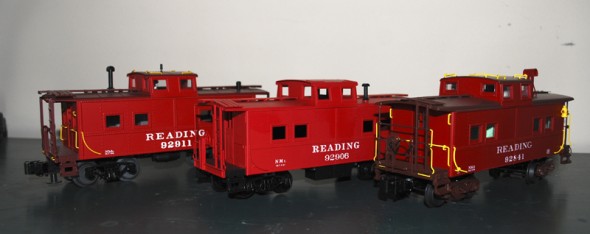
The three options – MTH, Weaver and Lionel
I’ve made a lot of posts about the locomotives on the front end of the train, at some point in time you have to think about the caboose at the other end.
One of the attractive things about modeling the Reading in O scale is that there are multiple options available for modeling Reading cabooses in both plastic and brass. We have been blessed with three plastic versions of the standard Reading NorthEastern Caboose. We have also had Brass versions built by Overland, Sunset, and International.
One thing that we should talk about first is that there is not really a Standard Reading North Eastern Caboose. There were a total of 285 Cabooses built from 1924-1948 in twelve different classes. Here is a chart of the different classes built and some of the detail differences.
| Class | Numbers | Built | Qty | Length | UF | Draft Gear | Trucks | RB | CW | Sheathing | Toolbox |
| NMd | 90730-90739 | 1924 | 10 | 31′ 4″ | RS | Miner | Taylor | W | W | Steel | Yes |
| NMe | 90710-90719 | 1926 | 20 | 31′ 4″ | RS | Miner | Taylor | W | W | Steel | Yes |
| NMf | 90720-90729 | 1927 | 10 | 31′ 4″ | RS | Miner | Taylor | W | W | Steel | Yes |
| NMg | 90700-90709 | 1930 | 10 | 31′ 4″ | RS | Miner | Taylor | W | W | Steel | Yes |
| NMg | 92800-92809 | 1930 | 10 | 31′ 4″ | RS | Miner | Taylor | W | W | Steel | Yes |
| NMh | 92810-92829 | 1931-32 | 20 | 31′ 4″ | CS | Gould | Taylor | W | W | Steel | Yes |
| NMj | 92830-92854 | 1936 | 25 | 32′ 8″ | WS | Duryea | Andrews | Flush | Integral | Steel | Yes |
| NMk | 92855-92879 | 1937 | 25 | 32′ 8″ | WS | Duryea | Taylor | Flush | Integral | Steel | No |
| NMl | 92880-92929 | 1941 | 50 | 32′ 8″ | WS | Duryea | Birdsboro | Flush | Flush | Steel | No |
| NMn | 92930-92979 | 1942 | 50 | 32′ 8″ | WS | Duryea | Birdsboro | W | Integral | Wood | No |
| NMo | 94000-94049 | 1943 | 50 | 32′ 8″ | WS | Duryea | Birdsboro | Grating | Grating | Steel | No |
| NMp | 94050-94074 | 1948 | 25 | 32′ 8″ | WS | Duryea | Taylor | Grating | Grating | Steel | No |
Let’s look at the plastic options.
Weaver Northeastern Caboose
First and oldest of the plastic options is the Weaver Northeastern Caboose. It was originally released in the 1990’s and it shows it’s age. It has a wooden roofwalk which makes it correct for the early classes NMd, MNe, MNf, NMg and NMh. It also has the toolbox under the center of the caboose that these early caboose had.
Negatives:
- They have molded on grab irons
- Not that many different parts.
- The factory supplied trucks are wrong for 1952, they should have Leaf Springs in the trucks instead of the freight trucks supplied by Weaver.
- Factory Paint job is wrong Red/Black combination, it is a Red/Brown combination
- Cross members on the underbody should tapper to flush with the car body at the edge.
Positives:
- They can often be found very cheap at train shows and on eBay.
- Dispite their age they are accurate models
Next up is the MTH Northeastern Caboose. Of the three plastic models this is the only one with a true prototype problem. The windows on the side of the caboose are set too far apart.
Negatives:
- Windows not correctly spaced.
- The factory supplied trucks are three rail, no two rail version available.
- Trucks are wrong for a car with a wooden roofwalk, should be Taylor Caboose trucks
- Modern Roof vents for the lavatory inside date the model to a later version then my modeling period.
- Tool box should be under the cars with the wooden roof walks.
- Strange cyclops light on the end of the car.
- Also has MTH type of end casting that fills in under the roof line of the car.
Positives:
- Factory paint job is close Red/Brown combination. Trucks should be brown also.
- Separately applied grab irons but they are a little heavy and should still be replaced.
Lionel Reading Northeastern Caboose
The Lionel Reading Northeastern Caboose #6-17682 is the most recent addition to the plastic options. It was first produced in 2007. As built, it is a model of the last two classes of cabooses NMo and NMp with a open grid roofwalk.
Negatives:
- Most expensive of the three plastic options.
- Oversized working smoke stack.
- Marker Lights are attached to one end.
- Only Three rail versions available from the factory.
- Grab Irons are oversized and should be replaced.
- No rivet detail on the roof.
- Lettered for a NMj, detailed for a NMo or NMp.
- The roofwalk has Lionel’s normal pins for holding down the roofwalk.
Positives:
- Factory paint job is a good start point.
- Great start point to build the modern classes of Reading Cabooses.
- Captured the slope of the end of the roof line over the steps (if viewed from the side)
These detail photos show the lack of rivets on the roof. This can be corrected with Archer rivets.
Reading K1 Progress
I haven’t posted anything on the K1 project in a while. It has been sort of almost on hold.
I found the above parts for the trailing trucks. But it wasn’t a complete truck, and I wasn’t sure who made it. I sent emails out to a number of folks asking if they knew who made the parts and if anybody had any more.
I also ran into a bit of a problem with tender trucks. I ordered a pair of their 584 on their website which lined up perfectly on the plan. When I went back to get more, they were out of stock and they were not sure if they would be re-run. I have since brought my truck total up to four. I still need one more set.
This is all part of the fun of building in O scale.
Baldwin VO-1000 #79
One of the switchers I’ve chosen to model is Reading class OE-10 #79. It was a Baldwin VO-1000 switcher assigned to Gordon, PA during my modeling time-period.
I’m going to use a Car Works VO-1000 model as the starting point. Car Works imported the VO series back in the early 90’s. They imported three versions, “VO-1000 1942-1944 #Curved Walks,” “VO-1000 1945-1947 Straight Walks” and a “DS4-4-1000 with FLat Grill.” They have a Weaver chain drive with Pittman motor. Out of the box they run fine. I may explore using a different drive set-up.
Looking at the fireman’s side there are shutters in two of the engine compartment doors, they will need to be added. The exhaust stack needs to be extended. I will need to add a cover for the radiator. Since my model has broken solder joints on one of the foot-boards at each end I think all four need to come off, be cleaned up and re-soldered back on.
Looking at the engineer’s side of the locomotive. There does not appear to be many changes needed. I’ll have to add a number board to the lower part of the radiator screen. This view shows the radiator cover removed in 1956, so maybe I don’t need to add it. The Reading rain gutters will need to be added to the cab roof.
Layout Visit: Cherry Valley Model Railroad Club, 2010
Reading Modeling Myth #1-Will the “Real” RDG Pullman Green Please Stand Up – Part II
Just when I thought I got away from paint color debates by not modeling the PRR…….
This morning I had the pleasure of testing some greens from Scalecoat 2. The Scalecoat made for plastics.
I tested six new greens.
Top Row: Pullman Green, Great Northern Empire Builder Green, Northern Pacific Dark Green
Bottom Row: Erie Green, New Haven Hunter Green, Coach Olive
This time instead of trying to match scans on the computer I went back to a technique from art school to match color. I had my samples above and cut a square in the paint sample. Then I placed the samples over different photographs.
My results so far:
For a locomotive within the first couple of years from being delivered Tru-Color New Haven 401 Green or Scalecoat 2 Erie Green were the closest.
For a locomotive 5-10 years from being delivered Polyscale Pullman Green.
Next step put some paint on the models and see what they look like.
Reading Modeling Myth #1-Will the “Real” RDG Pullman Green Please Stand Up
My brother sent the title as a title to an email a few days ago along with his interpretation of Reading Pullman Green.
Well I have calmed down from my frustration of last week. Now I just want to know what color first generation road switchers are to be painted for 1952? Simple answer, Pullman Green. But what is Pullman Green? It seems everybody has a different idea of just what that is.
After finding out that the Scalecoat 1 Pullman Green is some strange form of crappy brown, I realized I will have to test some paints.I first went out to the LHS and picked up some Polyscale greens. Then I used the testing as an excuse to try Tru-Color Paint. I ordered it online from P&D Hobby Shop and it arrived yesterday during a thunder storm. The box was soaked, glad the decals that I ordered did not ship in that box.
The Tru-Color paint is nice. Their Pullman Green is much better than Scalecoat’s Pullman Brown, but to my eye it still does not look like what is on the locomotives. The Great Northern Empire Builder Green next to it looks better.
Well I thought about it and decided to open the scans up in Photoshop and let something other than my eye look at it.
PhotoShop says that the Tru-Color Pullman Green is the closest to the two scans. My eyes still do not believe it.
I have to paint something now to prove it to myself.
